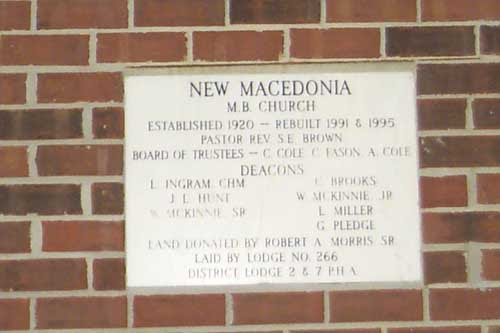
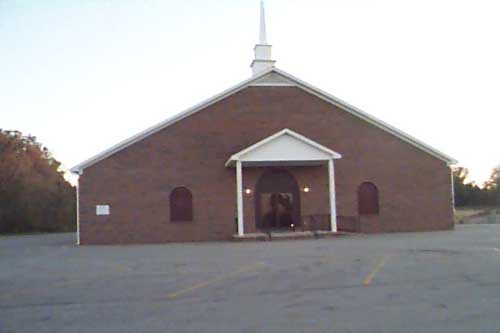


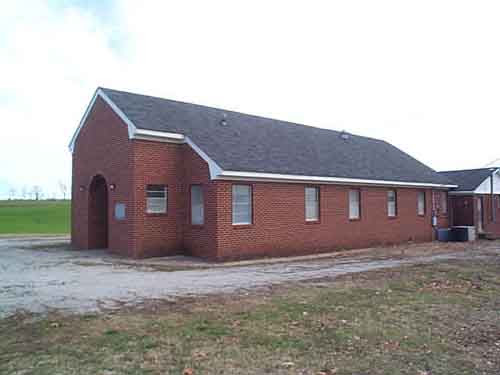
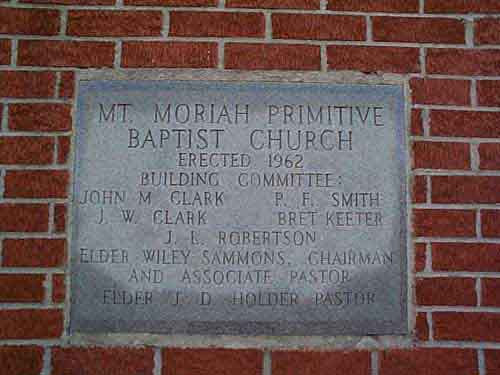
These photos were taken in March 2001 and contributed by Natalie Huntley.
Bits and Pieces of Crockett History
Crockett County Historical Society Files
A History of Mill Creek Primitive Baptist Church
By Frances (Williamson) Pollard
Six Weekly Installments featured in the NEWS, Friendship, Tennessee from 10/05/77 – 11/10/77
The “Countyline Baptist Church of Christ Primitive” was organized on Saturday before the second Sunday in June, 1829. The meetings were held in the homes of members until the autumn of 1830. At that time several of the men in the community, not necessarily members of any church, felt the need for a place of worship for their families. They erected a building of logs; the cracks were lined with handhewn boards. The floors were “puncheon” (split hewn logs). The seats were of split handhewn logs supported by stout wooden legs. The size of the building was approximately 20′ by 35′. The seating capacity was approximately 100 persons. They named the church “Old Liberty”. This was used by all denominations.
The original charter members of this Primitive Baptist church were: Stephen Booth, Sr., Stephen Booth, Jr., Penlopy Booth, S.H. Henderson, Elizabeth Guffy, and a slave of Benjamin Booth called T.O. There were 17 other members. During slavery days, the slaves were members of the same church as their masters. Their masters would use the front part of the church while the slaves used the back part, worshipping at the same time. This arrangement was carried on until about 1868. Brother Hosea Lanier was the first regular pastor; his tenure was 1832-1835. He had a common education and was an ordained minister.
On Friday before the second Sunday in May, 1833 the Mill Creek Baptist Church of Christ Primitive was constituted. Volume I of the church minutes was in the possession of Mrs. Laura Harrell, and according to her daughter, Mrs. Pauline (Harrell) Austin, was destroyed when Mrs. Harrell’s house burned many years ago. However, church records survey was made in the late 1930’s by Malcolm Gibbons, Supervisor for a WPA project, who examined the book and found it to be in good condition. These were the records of the earliest church. In most instances, they were clearly legible, having been written in ink with an old “goose quill” pen. The following statements appeared in the records and are copied with spelling and verbiage as originally written: “CONSTITUTION OF MILL CREEK CHURCH: Having been regular baptized upon a profession of our faith in Christ and being convinced of the necessity of coming together in church Government in order that we mite set in order the things that may be found wanting in the house of God and for that purpose have agreed to come together upon the following plan or regular form of government.
1st. We are taught in the Scriptures that we should give ourselves to the Lord and to one another by the will of God. That we should watch over each other for good and pray always and in everything give thanks.
2nd. We further agree that in all matters of dealing one with another that we will take the Scriptures for the Man of our council as recorded in the 18th chapter of Matthew and other Scriptures relating to discipline and that we will endeavor to love one another and to have fervant charity among ourselves and to watch over and care for the poor.
3rd. As we believe the gospel was appointed by Almighty to feed, comfort and build up His dear children, and for the advancement of His Kingdom on earth, we agree that it is our duty to throw in from time to time as God may or has prospered us, to the support of the gospel ministry.
4th. We also agree to maintain the doctrine of the gospel as we will set forth hereafter upon this plan or form of government. The church, at Dyer Meeting House, was regularly constituted by Elder James Farrell and William Patrick, who were called on by us as the presbitry for that purpose, on Friday before the second Sunday in May 1833, and adopted by Mills Creek Church.” The above was followed by the Rules of Faith and Articles of Decorum. One of the articles stated that there would be no whispering or talking during a public speech.
Mill Creek members used the Old Liberty building until 1844, when they erected a church building in the 6th Civil District near Dry Hill schoolhouse. They used the school building for services until the church building was completed in 1845. This was a frame building, weatherboarded style, or wooden construction throughout, with plain glass windows, and a seating capacity of about 200. In 1891 another building was erected in the 14th Civil District one mile east of Johnson Grove on the Alamo-Johnson Grove road. This building was also a weatherboarded one, or wooden construction throughout. The material used was No. 1 yellow poplar; the lumber was selected and then handplaned to the desired dimension. This oblong shaped building was 36′ x 45′ and had outside shutters covering the entire windows, which were of plain glass. It was constructed with the utmost care and skill, and would seat about 300. The floor was of unplaned No. 1 yellow poplar lumbar that soon became worn smooth with usage. The pulpit was a raised dais platform, 6′ x 8′ in size, with a bookrest about forty inches high mad of No. 1 pine flooring and varnished in walnut. The pews were of No. 1 poplar lumber about one and a half inches thick; they were not painted. The interior walls of the church were finished with a walnut varnish, except for the ceiling and floors, which were never painted. There were two acres of land that was the property of the church. The following regular deeds have been located: (1) In April, 1859 E.D. Norvill gave two acres to the Predestinarian Baptist church. The trustees of the church at that time were William Edwards, Enos Norville, and John Brooks. This is in Haywood County Deed Book Z, pages 18 and 19. (2) On September 18,1881, J.W. Evans stated that he had made a deed to Mill Creek Baptist church in 1871 or or 1872 and it had been lost or mislaid; in the transaction, he had sold an acre of land to the church for $30.00. The trustees were S.W. Smith, John Carter, and Z.P. Warren. This tract was adjoined by lands belonging to J.J. Robbins and Fraink Kail. This is in Crockett County Deed Book E, pages 370 and 371. (3) William and Sarah Kail; R.H. Proctor and his wife, R.J.; and Dorsey C. Thomas gave two acres to the Primitive Baptist Church in District 14, of which the trustees were: J.J. Edwards, J.H. Smith, and Z.P. Warren. The two acres were bounded by the lands of William Kail, Proctor, and Winford. This is recorded in Crockett County Deed book K, page 94. (4) On August 1, 1890, Z.P. Warren, J.J. Edwards and J.H. Smith, Trustees, sold all the land that was “now owned by the Primitive Baptist Church at Mill Creek” to Frank Kail. This is in Crockett county Deed book M, pages 408 and 409.
The following account was taken from Volume 2 of the Church Minutes, now in possession of Mrs. Ruth (Edwards) Appleby of Bells. She was kind enough to allow us to copy them, and we thank her. Her father, Mr. G.W. Edwards was Church Clerk for many years.
“1879—Whereas there was much strife and confusion existing in the church; we had one called meeting before the one started below for an adjustment of our grievances and all concerned agreed to drop the matter. However, the differences and confusion was raised again and therefore the necessity for this called meeting. On Saturday before the fifth Sunday in May, 1897, the Church at Mill Creek met and after praise by Elder J.M Whitenton and prayer by T.H. Marshall, came together in conference. (1st) Z.P. Warren and J.F. Carter were elected moderators and J.B. Ezell was elected Clerk. (2nd) Agreed to be governed by the rules of our church decorum. They were read (3rd) A statement of the object of the meeting was made by Elder Thomas who was the pastor at the time, that there was a doctrinal difference existing among us and that it had caused many hurtful things to be done and said, and that our objective was to settle it, and we believed it could be done by strict adherence to the Bible, to which Brother J.H. Smith replied agreeing with Elder Thomas that it was a doctrinal difference. Response by S.L Lomax, Elder J.M. Whitenton and Elder H.W. Thomas. The outcome of the called meeting was that we withdrew fellowship from those of our brethren who had a difference of doctrinal opinions. Signed: Z.P. Warren, Church Moderator” D.E. Wagster was appointed Church Clerk for the remaining members. The following brothers and sisters withdrew fellowship at this time: J.M. Whitenton, S.L. Lomax, Vanner Lomax, J.F. Carter, J.B. Ezell, J.H. Smith, George Kail and Spencer Buford. It appears that the departing members took the Minute book, since at a meeting held in June, 1897, the committee composed of William Kail and J.H. Jones was appointed to apply to J.B. Ezell and request that he relinquish the book. In July, 1897, the committee reported that Mr. Ezell refused to do so. (Apparently this was Volume 1.) At this meeting, the church clerk was instructed to purchase a new minute book This was Volume 2, which is now in the possession of Mrs. Appleby.
According to the minutes dated July 31, 1897, the departing members “did forcibly break and enter illegally and unlawfully take possession of the church house, remove the lock and put on a new one, retain the key, and bar the doors and continue to hold possession in violation of law against the will and wishes of the Church; therefore be it resolved that our Trustees, to wit: Z.P. Warren, Gray Edwards and Henry Jones, in connection with the members of the church employ council and proceed to eject said members in their unlawful holding of said church property. They are hereby authorized to prosecute and carry on said suit in behalf of the church” In October a committee was appointed to “see after paying the expense of the suit”. At the time of the November meeting, they had retained Lawyer Poston and were attempting to raise the money. In November, 1898, the committee was asking for still more time to raise the money to pay William Poston his fee. An injunction was obtained against the departing members; they moved to a new building at Maury City. (A history of this branch of the church will appear at a later date in this column.) On the third Sunday in December, the committee reported that Mr. William Poston had been paid, and the committee was discharged. In October, 1899 G.W. Edwards was appointed Church Clerk pro tem.
In September, 1900, Mr. E.E. Wagster’s resignation was accepted and Mr. Edwards was elected Clerk. (note the time lapse). Elder H.W. Thomas resigned, and in August of 1901 Brother C.F. Caruthers was called as pastor. Fellowship was subsequently withdrawn from Elder Thomas. In January, 1904, C.F. Caruthers resigned and L.H. Stuckey was elected Moderator pro tem.
In April of 1905, the following letter was entered in the minutes: “Dear Brethern. Whereas you are aware that I have been charged with great and grevious charges I hereby most emphatically deny my guilt of the same, neither have I had any criminal intentions in any of my conduct, but I will acknowledge that I have been indiscreet at times through carelessness, unthoughtedness, acted imprudent by without properly taking care for the impression I was making upon others and have thereby left room for others to misunderstand me and suspicion me of wrong intentions for all of which I humbly and earnestly ask all of my brethern every where to forgive me and I will promise to try to do so like in the future as to give room for no suspicion. Brethern pray to God for me that I may live to the honor of His most holy cause.” (name being withheld.)
In September of 1905, fellowship was restored to Brother Thomas and he was again called to the Pastoral care of the church.
A committee was appointed in November of 1905 to “see about painting and repairing the church.” In May, 1906, the committee reported that the work had been completed and paid for, and the committee was dismissed.
By 1907 the church had lost several members, but in August of that year the following united with the church: S.L. Eason, M.J. Eason, W.A. Thomas, E.E. Thomas, B.B. Edwards, Lou Edwards, J.F. Faulkner, M.A. Faulkner, G.C. Perry, John Copher, and D.B. Thomas. M.A. Copher had fellowship restored.
In October, 1908, the following letter of respect was entered in the minutes: “Whereas: God in His all wise providence saw fit on October 6, 1908 to remove by death one of our members in the person of Esq. Z.P. Warren. Whereas: we the Primitive Baptist Church of Christ in session at Mill Creek, Crockett County, Tennessee, on Saturday before the 3rd Sunday in October 1908 resolve to give expression of our sorrow and grief of our great loss. Brother Warren will be greatly missed by us all as he was punctual in attendance and always ready to bear his part and speak kind words and assist those in trouble and with all his long life of membership in this church not a blot or a stain was seen against his character as a Christian . Indeed he was a model Christian and Oh! How he will be missed by us today. Now all we can do is look up to God in sorrow and through a great mist of tears beg for grace sufficient that we mourn not as those that have no hope but as we are here our loss is his eternal gain. God assist us all to say ‘the Lord giveth and the Lord taketh away, blessed be the name of the Lord’. We resolve further that this resolution be spread upon our church book and also a copy be sent to the Crockett County Sentinal and the Apostolic Herald with a request for publication and a copy be sent to the family. Elders H.W. Thomas and G.W. Edwards, Committee.”
Elder J.W. Adams was called as pastor in October, 1914, and served until December, 1928. At that time, W.E. Blackburn was elected pastor.
Volume 3 of the Church Minutes was begun in May, 1918. This record book was in the possession of Mr. Ira Brasfield; at his death it became the property of his son, Cornelius, who was kind enough to let us use it.
In September, 1923, a new roof was installed. Two trees from the church lot were sold in November of 1929 to raise money to have the church building repaired; that sale brought in $50.00.
W.E. Blackburn resigned in January, 1936 and Harvey was elected pastor.
In January of 1939, it was reported that the church had been painted and repaired at a cost of $113.04, which was $3.35 more than the church had in its bank account. However, $8.70 was received for the cotton raised on the church lot; this was enough to complete the payment of the bill and leave a balance of $5.35.
On September 7, 1944, the church voted to sell Mill Creek church and the lot on which it stood; J.N. Warren and Ira Brasfield were appointed as a committee to sell the property at public auction. On September 16, 1944, the report was “the proceeds of the sale of Mill Creek Church and lot and other property to the amount of $859.25, which was deposited today in Peoples Bank at Alamo, Tennessee as Mill Creek funds. J.N. Warren, Church clerk.”
The last entry in the minute book reads as follows: “On this day we, J.N. Warren, J.E. Clement and Ira Brasfield drawed out the money of the Mill Creek Church funds to the amount of $909.99 and divided among members of Mill Creek to the amount of $75.83 apiece. This 12th month and 3rd day of 1946. J.N. Warren, Church clerk.” In my mind even today I can see those dear people as they made this last entry, carefully closed the book, and, with tears streaming down their faces, gave each other the hand of Christian fellowship, and walked away from the place that had been such an important part of their lives.
An incomplete list of the former members of Mill Creek Primitive Baptist Church follows: J.N. Adams, J.N. Anglin, Annie Baker, Ceity Baxter, Samuel Baxter, W.E. Blackburn, L.E. Boals, Comodore Bran, Julie Brasfield, Tom Brasfield, W.A. Brasfield, Ira Brasfield, Mrs. Eddie Bridger, Gray Buford and wife, Lennie Buford, Spencer Buford, Mable Byassee, L.F. Carter, Nannie Carter, Ora Maie Carter, C.F. Caruthers, Sally M. Caruthers, J.E. Clement, Ella Colvett, J.W. Colvett, Betty Copher, John T. Copher, J.H. Copher, Mellissa A. Copher, Minnie Cousins, Annie Crow, J.H. Crow, J.J. Crow, J.H. Dailey, Alva Lou Davis, D.E. Ditto, M.H. Ditto, M.J. Eason, S.L. Eason, Ada Edwards, B.B. Edwards, D.L. Edwards, Eva Edwards, G.W. Edwards, Lafayette Edwards, Letha Edwards, Lou Edwards, M.J. Edwards, Nannie Edwards, Nannie Cayce Edwards, Nora Edwards, Susan Edwards, J.D. Elkins, Claude Dewey Ezell, Eva Ezell, J.B. Ezell, Sally Ezell, J.F. Faulkner,Lela Faulkner, Loula Faulkner, Martha Ann Faulkner, M.J. Freeman, Earnest Garrett, Mattie Garrett, Sarah Garrett, W.G. Garrett, Mat Glanden, H.L. Greer, P.G. Greer, Snellie Greer, Ezra Hamilton, Laura Harrell, Sister M.E. Hill, Nannie Jetton, P.G. Johnson, Fannie Jones, J.H. Jones, Alice Kail, Clarence Kail, Ellie Kail, George Kail, Hester kail, Sarah Kail, Sapphire Kail, William Kail, Fannie Leggett, Simon Leggett, S.L. Lomax, Vanner Lomax, Nancy Lunsford, Nannie Luton, John Marcum, Minnie Marcum, T.H. Marshall, G.E. Mayfield, Nellie McCain, Julia Mydget, Maron Mydget, Tennie Neal, Mattie Oliver, J.L. Only, J.HJ. Parker, G.C. Perry, Guy Perry, M.J. Perry, R.L. Perry, J.H. Phillips, Annie Pittner, Jemima Poindexter, John Prescott, Edd Proctor, Edna Maie Proctor, Eva Proctor, Eliza Proctor, Jane Proctor, J.P. Proctor, Lela Proctor, Millie Proctor, S.D. Proctor, Vinia Sue Proctor, Ludie Reece, J.H. Riddick, Early Robertson, G.C. Robertson, Lou A. Robertson, Mandy Robertson, T.W. Robertson, W. H. Robertson, W. Noah Robertson, J.H. Smith, Lula Smith, Mollie smith, Gib Stallings, Y. Stallings, Nancy Stamps, L.H. Stuckey, M.E. Stuckey, Miss Anna Taylor, Benjamin Taylor, B.J. Taylor, Mrs. Lou Taylor, R.C. Taylor, Bradon Thomas, Etha Thomas, D.B. Thomas, E.E. Thomas, Fannie Thomas, H.W. Thomas, Jim Thomas, Mary Thomas, John Thomas, M.A. Thomas, M.L. Thomas, W.A. Thomas, Dixie Thompson, W.B. Thompson, Cynthia Viers, D.E. Wagster, Mattie Wagster, Minerva Wagster, Mattie Wallace, W.M Wallace, L.M. Wainwright, Drucila Ward, J.N. Warren, Miranda Warren, Z.P. Warren, J.M Whitenton, Lula Whitenton, Alice Woods, John Woods.
……….
Mill Creek Primitive Baptist Church No. 2
By Maxine Mayo
Article from the NEWS, Friendship, Tennessee, 11/10/1977
Following the doctrinal dispute of the members of the church in the 1890’s which resulted in the withdrawal from the church of one of the factions, that group built another church at Maury City, which was also called Mill Creek Primitive Baptist Church. In July of 1901, W.M. King sold an acre of land on what is now Highway 88 to J.F. Carter, J.B. Ezell, and J.M. Whitenton, the trustees of the church, stating that a church was to be built on the land to be the property of the members who would hold to the doctrine of the church and would oppose all new innovations of doctrine or practice. Sam L. Lomax was the pastor of this church from 1897 to 1919, during which year the church burned. By that time, there were so few members in the area that the decision was made not to rebuild on that site, and the lot was sold to J.R. Burton (Crockett Co. Deed Bk. 6, p. 519).
In 1919 H.H. Lanier gave a tract of about 2 acres in District 9, about 5 miles northeast of Crockett Mills, ½ mile off the Nance’s Schoolhouse-Eaton road, and about 3 ½ miles north of Nance’s School: the cemetery measured about three-eighths of an acre. A church with a seating capacity of about 180 was built there, and was still known as Mill Creek Primitive Baptist Church. John W. Kirley served as pastor of this church from 1919 to 1935; in 1935 the church, with a membership of 23, became defunct.
From the foregoing, it is seen that, for a period of almost forty years, there were two Mill Creek Primitive Baptist churches in existence in Crockett County at the same time.
……….
DAN C. JOHNSON AND THE COUNTY LINE CHURCH
By Maxine Mayo
From the News, Friendship, Tennessee, November 10, 1977
After the above information had been compiled, the following item was located: Rev. Dan c. Johnson. Son of Isaac Johnson, in a letter to the Alamo Weekly Guide of Aug. 25, 1916, stated that, as a boy, he attended “old County Line meeting house, which stood by where Elder J.H. Farrow’s residence is located.” He said that in one sermon, the preacher denounced playing marbles as being a worldly, and, therefore, evil activity and, at the end of the sermon, concluded about the players that, “ The whole couple will go to hell like a whirlygust of woodpeckers”.
Contributed by Vicki Thomas Annico
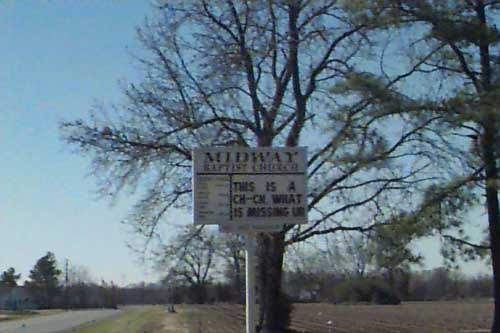
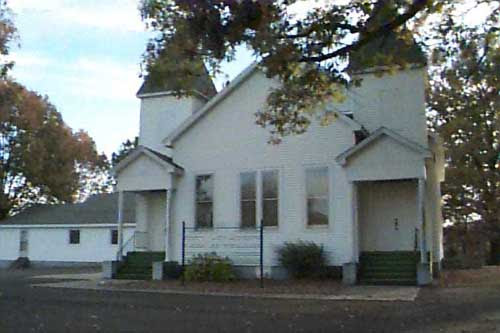
This is a letter that was with my grandmother, Mary Rachel GEAN GILMAN’S belongings. My mother had this and passed it on to me. Maybe someone can add to the history of this Church. My surnames in the letter are GILMAN, GEAN, MAHON and PERRY.
Shady Grove Church, – Out of which came Johnson Grove Church
Organized June 13, 1855 with two members, a Brother WILDER and Simon D. SPIGHT. Preachers assisting in the organization, Samuel H. BETHEL, David JORDAN and Z.N. MORRELL. Brother BETHEL was the first Pastor. Simon SPIGHT , first clerk.
In August 2 were received by letter, Ann NUNN and Alsey NUNN and Issac KOONCE by experience.
Almost at every meeting, they called “mourners” and often the clerk would say, “Many came forward”.
In August 1836 Zilpha NUNN and her sister Nancy NUNN joined by letter.
They observed the Lord’s supper 3 times a year regularly.
Many of the slaves of David NUNN, Great Grandfather of I.B. TIGRETT were received and Baptized into the fellowship of the Church.
Pa (Franklin Epperson MAHON) joined the Church on Sunday, Sept. 12, 1837 and on Sept. 17 was Baptized in the Forked Deer River at Eaton by Pastor Bro. BETHEL.
During a revival in November 1837, Aunt Clemenda (MAHON), another white woman, and a negro slave joined at the same time and were Baptized by HALLIBURTON.
Martha MAHON joined the Church. First Sunday in March 1838. I think she married John MAYFIELD and went to Texas with Uncle Bently(MAHON).
At the meeting in July, Brother F.E. MAHON (Franklin Epperson MAHON) came to Church and confessed he had done wrong in quarreling with Bro. SPIGHT and was forgiven.
Elizabeth MAHON(Aunt Bessie evidently) joined the Church third Sunday in October 1839.
On third Sunday in October 1940, Eliza Jane MAHON or Elizabeth Jane MAHON(hard to read) joined the Church and was Baptized Saturday before first Sunday in December.(It says 1940, but could be 1840??)
Bently MAHON joined the Church on third Sunday in March 1843 and was Baptized the following day.
I am to get the other old Church book from Hill BURNETT and will follow up this and let you have the data.
I never knew before where Mat (MAHON) got her name, Martha Clemenda, did you know?
NOTE, We have greatly enjoyed Ruth’s(GILMAN) visit, only wish she could have stayed longer. I know you have missed her. She is a fine girl and we are fond of her.
Bob MAHON
Who would be Robert PERRY MAHON.
Contributed by Karen Martin
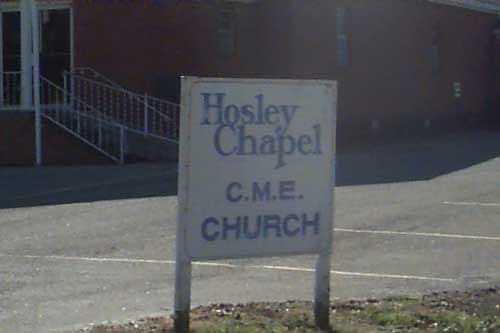
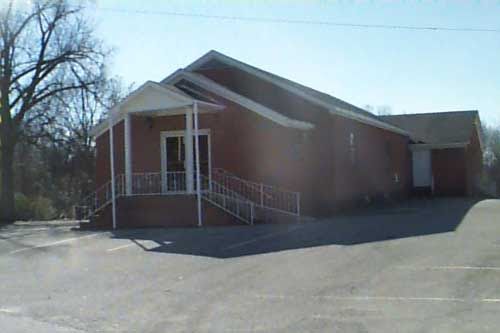
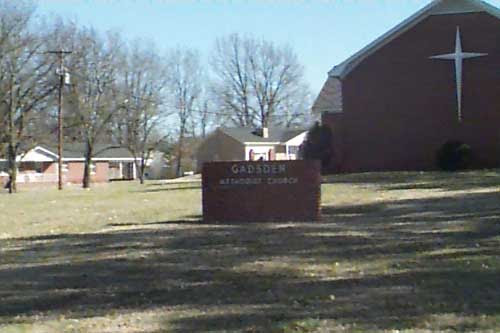
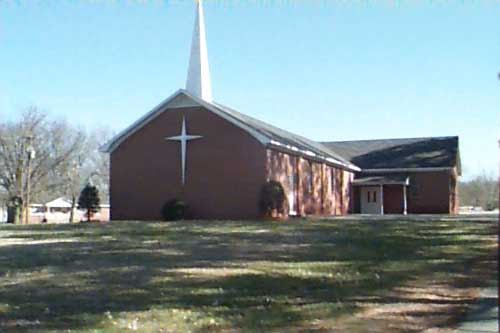
The Methodist Church was first formed at Mason’s Grove before 1885. One of the founders was David Brandenburg. The church was later moved to Gadsden and located South of the railroad near where Mr. and Mrs. Guy Renfro now live. Later the congregation built a small frame building up on the highway. A few years ago a big, beautiful brick Church was erected on the highway location. Some of the families attending there now bear the names of Byrd, Mitchell, Emison, Williams, Leggett, Nelson, Young, Lowery, Antwine, Heglar, Burrow, Davis, Simmons, Holyfield. The oldest members are Mrs. Zach Mitchell and Mrs. Ness Persell. The official church board at this time consists of Merlin Leggett, Clyde Byrd, Thomas M. Williams, Jessie Lee Antwine, W. F. Latham, Theo Mitchell, and Billy Booker.
The preceding article was contributed, with permission of the Crockett County Historical Society, by Natalie Huntley.
This information was taken from an article on Gadsden, which was compiled and written by Mrs. C. C. James, and published in the book Crockett County Courthouse Centennial, 1874 – 1974, prepared by the Crockett County Historical Society.
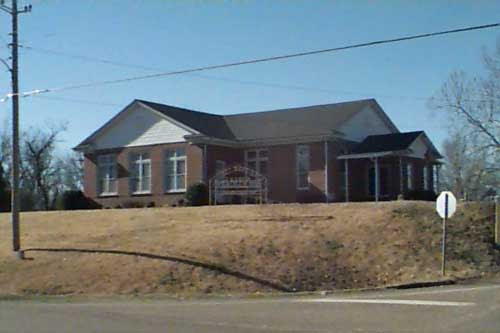
The Gadsden Baptist Church was organized in 1866. The first building had one room and was built of logs. It was later burned to the ground after being used as an infirmary during a small pox epidemic. A small frame building was then built and used until 1926, when the first section of the present building was built. It was of brick and consisted of a sanctuary with three open alcoves along each side to be used as classrooms. The pulpit was built by Mack Jones, a member of the church. The organist was Mrs. F. M. Henderson, long-time music teacher of children in the town. Since her death, one of her former pupils, Perry M. Carter, has been organist.
Early church rolls included such names as: Rosemon, Bird, Hunter, Daniel, Wallace, Reaves, Jones, Warren, Mitchell, Woodson, Young, Blurton, Strictland, Hopper, Guest, Cornatzer, Sutton, Hays, King, Pearson, Williams, Johnson, Jackson, Simmons, and Nelson. Most of these have descendants still attending the church.
In 1952, two classrooms were added and a large fellowship hall. The vestibule was added to the front of the church in 1956. A new parsonage has just been completed this year. A new piano was purchased in 1961 and the pianist now is Mrs. Erby Cornatzor. The communion set was given by the Family of Mrs. Willis Bolton in 1954, and is still being used. In 1965, a two-story addition was put on the back of the church. In 1972, a new baptistry was added and the first person to be immersed in it was Joyce Ann Henderson.
The preceding article was contributed, with permission of the Crockett County Historical Society, by Natalie Huntley.
This information was taken from an article on Gadsden, which was compiled and written by Mrs. C. C. James, and published in the book Crockett County Courthouse Centennial, 1874 – 1974, prepared by the Crockett County Historical Society.
1939 – Church was damaged by fire. The church placed a memorial window (she hand-writes that it is a stained glass window) to Mr. Fate Williams who left a Trust Fund to the Church. (she hand writes $500)
1940 – Pastor’s Home burned. Pastor resigned. Mrs. Sweats house purchased as pastors home. Mr. C. E. Mobley, M. V. Williams, Sr. and Mr. Ira D. Park were elected trustees. Rev. J. H. Miller called as pastor for halftime. Carroll Avery, Church Clerk.
1941 – The note on the Church indebtedness was burned, by George Williams and Ham Park. The church adopted Pastor’s retirement. Rev. T. E. Williams member of Executive Committee.
1942 – Rev. James Farrar was Evangelist for summer revival.
1943 – Pastor J. H. Miller resigned. M. V. Williams, Jr., Church Clerk.
1944 – Rev. Braxton Sams was called as pastor. Mrs. J. E. Privett, Church Clerk. The church went on record as opposing the sale of beer in Friendship. W. E. Bailey called as pastor. Messengers to annual Associational meeting were: Rev. and Mrs. W. E. Bailey, Mr. and Mrs. Ira D. Park, and Dr. W. H. Stallings. Mr. Johnnie Balentine was recognized as deacon.
1945 – A centennial Clinic was held in the church. Additions to church 5 for baptism and one by letter. Dr. and Mrs. W. H. Stallings presented a spinet piano. It was voted to have business meeting on Wednesday night instead of Sunday morning. Rev. W. C. Skinner was called as pastor at the salary of $1,500.00 a year.
1946 – The Church Roll was revised by a committee consisting of Rev. Skinner, J.F. Bailey, Mrs. J.E. Privett and Board of Deacons. The Baptist and Reflector was carried in Church Budget. An automatic stoker was installed.
1947 – Gifts to Union University was $510.00. A baptistry was installed. Voted to have full time preaching. There were 25 additions by baptism in a 12-day revival. Rev. Ray Dobbins, Evangelist.
1948 – Mr. and Mrs. J.C. Putman donated new pulpit furniture to church. Time for Sunday School set for 10:00 instead of 9:45. Raised salary of Caretaker to $25.00. Set budget at $3200.00.
Thank you, to Andy Williams for contributing this information.
Site last updated September 1, 2021 @ 7:54 am